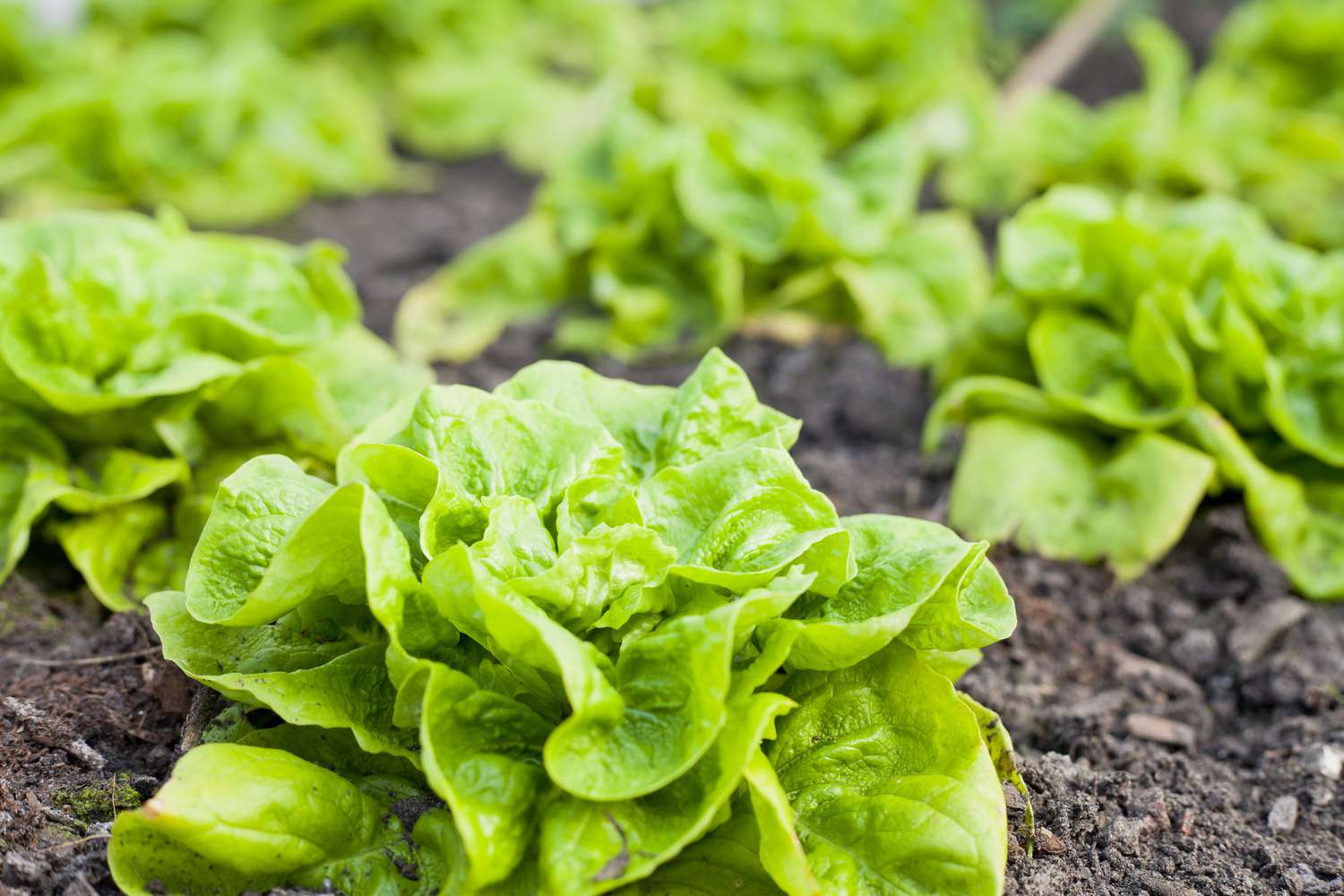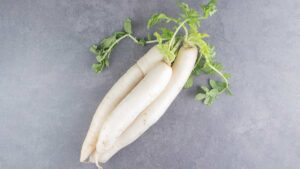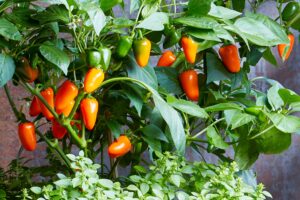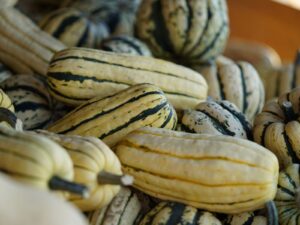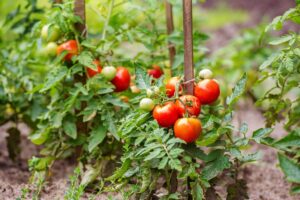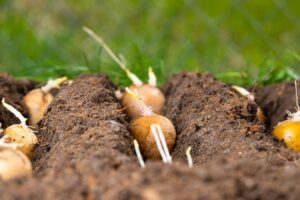How to Grow Lettuce: The Complete Guide for Home Gardeners
Growing your own lettuce at home is one of the most rewarding and practical gardening projects you can undertake. Fresh, crisp lettuce harvested minutes before mealtime provides unmatched flavor and nutrition that store-bought varieties simply cannot deliver. Whether you have a spacious backyard garden, a small patio with room for containers, or just a sunny windowsill, you can successfully grow lettuce year-round with the right techniques.
According to the USDA National Agricultural Statistics Service, lettuce is one of America’s most valuable crops, with the US market producing over $2 billion worth annually. Now, you can bring this nutritious green into your own home growing space, saving money while enjoying premium quality produce.
Why Grow Your Own Lettuce?
Before diving into the how-to aspects, let’s explore why growing your own lettuce makes so much sense:
- Freshness: Harvest right before eating for maximum flavor and nutrition
- Cost savings: A $3 packet of seeds can produce the equivalent of dozens of store-bought lettuce heads
- Variety: Access to unique heirloom varieties not found in supermarkets
- Chemical-free: Control what goes into your food
- Reduced food waste: Harvest only what you need, when you need it
- Space efficiency: Lettuce can grow in minimal space
- Quick results: Many varieties are ready to harvest in just 30-45 days
Understanding Lettuce Varieties
Choosing the right variety for your growing conditions and taste preferences is essential for success. Lettuce generally falls into four main categories:
1. Loose Leaf Lettuce
Loose leaf varieties don’t form a head but rather grow individual leaves from a central stalk. These are perfect for beginners and small-space gardeners because:
- You can harvest outer leaves while the plant continues growing
- They mature quickly (30-45 days)
- They’re highly adaptable to different growing conditions
- Popular varieties include Red Sails, Black Seeded Simpson, and Oak Leaf
2. Butterhead Lettuce
These form loose, rounded heads with soft, buttery-textured leaves:
- More heat-tolerant than many varieties
- Delicate, sweet flavor
- Takes 55-75 days to mature
- Popular varieties include Bibb, Boston, and Buttercrunch
3. Romaine/Cos Lettuce
Known for upright growth and crisp texture:
- More nutritious than many other varieties
- Heat-tolerant
- Takes 70-85 days to mature
- Popular varieties include Parris Island, Little Gem, and Rouge d’Hiver
4. Crisphead Lettuce
The classic iceberg-type lettuce with tightly wrapped leaves:
- Most challenging for home gardeners
- Requires longer growing season (80-90 days)
- Needs consistent moisture and cool temperatures
- Popular varieties include Iceberg, Great Lakes, and Crispino
Best Growing Conditions for Lettuce
Lettuce thrives under specific conditions that you’ll want to replicate in your growing environment:
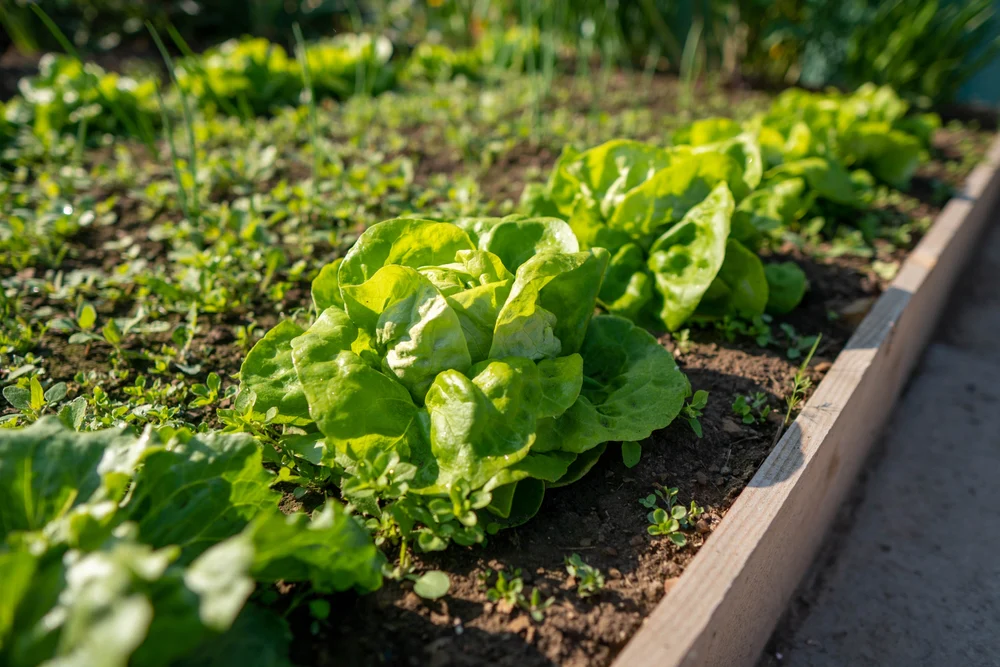
Temperature Requirements
Lettuce is primarily a cool-season crop. According to the USDA Agricultural Research Service, the ideal temperature range for lettuce growth is:
| Growth Stage | Ideal Day Temperature | Ideal Night Temperature | Minimum Temperature | Maximum Temperature |
|---|---|---|---|---|
| Germination | 65-75°F (18-24°C) | 60-65°F (15-18°C) | 35°F (2°C) | 85°F (29°C) |
| Growing | 60-70°F (15-21°C) | 50-55°F (10-13°C) | 32°F (0°C)* | 80°F (27°C) |
*Many varieties can survive light frost
When temperatures consistently rise above 80°F (27°C), lettuce tends to “bolt” (produce flowers and seeds), making the leaves bitter.
Light Requirements
- Outdoors: Lettuce grows best in partial shade, especially in warmer regions
- Indoors: 14-16 hours of light daily from either a sunny window or grow lights
Soil Requirements
- Well-draining, loose soil rich in organic matter
- pH level between 6.0 and 7.0
- Consistent moisture but not waterlogged
How to Grow Lettuce Outdoors in Garden Beds
Growing lettuce directly in garden beds provides ample space for succession planting and larger harvests.
Preparing Your Garden Bed
- Select the location: Choose a spot that receives morning sun and afternoon shade in warmer months, or full sun in cooler seasons.
- Prepare the soil:
- Remove weeds and break up soil clumps
- Mix in 2-3 inches of compost or well-rotted manure
- Rake to create a smooth, level seed bed
- Consider season extension: In colder regions, prepare to use row covers, cold frames, or hoop houses to extend your growing season.
Direct Seeding Outdoors
- Timing:
- Spring: Sow seeds 2-4 weeks before the last expected frost
- Fall: Sow seeds 4-8 weeks before the first expected frost
- Year-round succession planting: Sow small amounts every 7-14 days
- Planting process:
- Create shallow furrows about ¼ inch deep
- Space rows 12-18 inches apart
- Sprinkle seeds thinly along furrows
- Cover lightly with soil and gently firm down
- Water thoroughly but gently
- Care after seeding:
- Keep soil consistently moist until germination (usually 7-10 days)
- Thin seedlings when they reach 1-2 inches tall
- For loose-leaf varieties: thin to 4-6 inches apart
- For head-forming varieties: thin to 10-12 inches apart
Transplanting Seedlings Outdoors
If you’ve started seeds indoors or purchased seedlings:
- Harden off seedlings by gradually exposing them to outdoor conditions over 7-10 days
- Transplant on a cloudy day or in the late afternoon to reduce transplant shock
- Space properly:
- Loose-leaf: 4-6 inches apart
- Butterhead/Romaine: 6-8 inches apart
- Crisphead: 10-12 inches apart
- Water immediately after transplanting and keep soil moist until established
How to Grow Lettuce in Containers
Container growing is perfect for patios, balconies, or when garden space is limited.
Choosing the Right Containers
- Container size:
- Minimum depth: 6 inches
- Minimum width: 12 inches for a few plants
- Window boxes, grow bags, and repurposed containers all work well
- Drainage: Ensure containers have adequate drainage holes
- Material considerations:
- Plastic retains moisture longer
- Terracotta dries out faster but provides better aeration
- Self-watering containers are excellent for consistent moisture
Container Planting Process
- Prepare your container:
- Fill with high-quality potting mix (not garden soil)
- Mix in slow-release organic fertilizer according to package directions
- Leave 1 inch of space below the rim for watering
- Planting seeds:
- Scatter seeds over the surface, aiming for approximately one seed per square inch
- Cover with ¼ inch of soil or vermiculite
- Water gently but thoroughly
- Container spacing:
- Baby lettuce (cut-and-come-again): space seeds ½-1 inch apart
- Full-sized heads: thin seedlings to 4-8 inches apart depending on variety
- Container location:
- Spring/Fall: Full sun to partial shade
- Summer: Morning sun, afternoon shade
- Winter: Sunniest location available or under grow lights
Container-Specific Care Tips
- Watering: Containers dry out faster than garden beds; check daily and water when the top inch of soil feels dry
- Feeding: Apply diluted liquid organic fertilizer every 2-3 weeks
- Temperature management:
- Move containers to cooler spots during heat waves
- Bring containers indoors or into protected areas during extreme cold
How to Grow Lettuce Indoors
Growing lettuce indoors allows you to harvest fresh greens year-round regardless of outdoor conditions.
Setting Up Your Indoor Growing Space
- Light requirements:
- South-facing window for natural light (minimum 6 hours daily)
- Supplement with grow lights for best results
- Position grow lights 6-12 inches above plants for 14-16 hours daily
- Temperature considerations:
- Maintain room temperature between 60-70°F (15-21°C)
- Keep away from heating vents and cold drafts
- Air circulation:
- Use a small fan on low setting to prevent disease and strengthen plants
- Keep fan at a distance to avoid drying out soil too quickly
Indoor Growing Systems
- Simple container gardening:
- Use pots at least 6 inches deep with drainage holes
- Follow container planting instructions above
- Hydroponic options:
- Simple DIY systems with nutrient solution
- Commercial hydroponic kits specifically designed for lettuce
- Faster growth and clean harvesting compared to soil
- Microgreens approach:
- Use shallow trays with potting mix or coco coir
- Harvest entire plants when they reach 2-3 inches tall (10-14 days)
- Highest nutrient density of all growing methods
Indoor Lettuce Varieties
Some varieties perform particularly well indoors:
- Tom Thumb (small butterhead, compact growth)
- Black Seeded Simpson (loose-leaf, fast growing)
- Little Gem (mini-romaine, space efficient)
- Salad Bowl (loose-leaf, slow to bolt)
- Microgreens mixes (specially formulated for indoor growing)
Lettuce Care and Maintenance
Regardless of your growing method, these care practices will help ensure success.
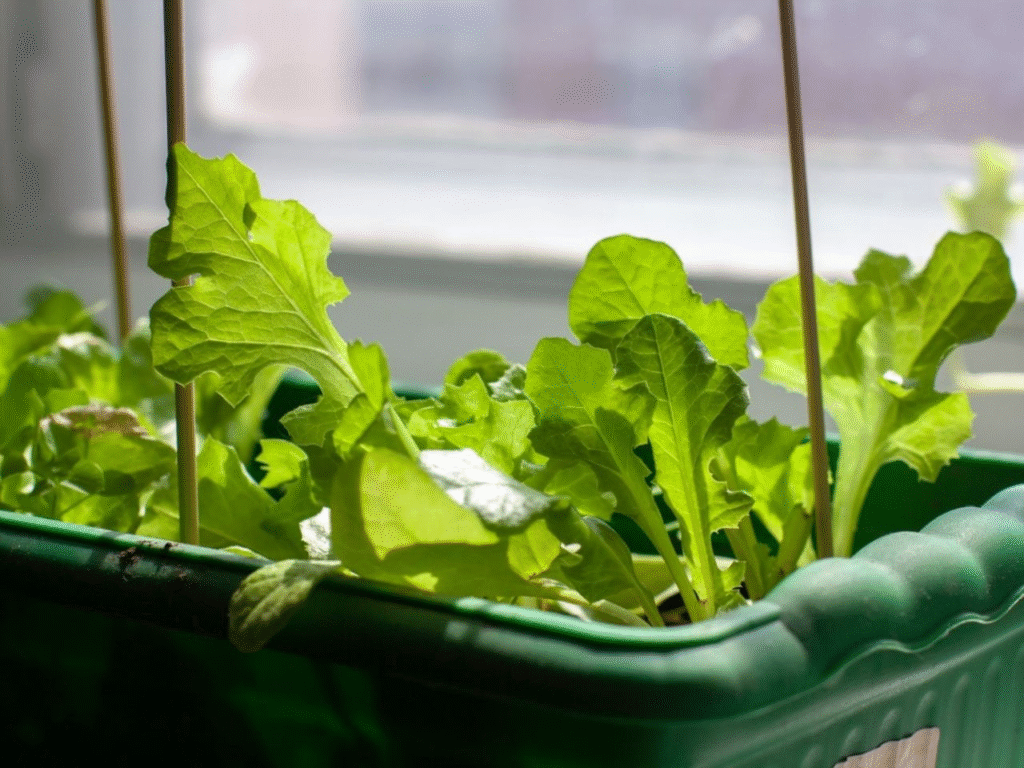
Watering Techniques
- Consistent moisture: Lettuce needs regular watering; soil should never completely dry out
- Watering methods:
- Drip irrigation or soaker hoses are ideal (keeps leaves dry)
- If overhead watering, do so in morning to allow leaves to dry before evening
- Mulching benefits:
- Apply fine mulch around plants to retain moisture
- Straw, leaf mold, or fine compost work well
- Keep mulch away from plant stems to prevent rot
Fertilizing Schedule
- Before planting: Incorporate compost or balanced organic fertilizer into soil
- During growth:
- Garden beds: Side-dress with compost tea or diluted fish emulsion every 3-4 weeks
- Containers: Apply diluted liquid organic fertilizer every 2-3 weeks
- Hydroponics: Follow solution replacement schedule for your specific system
Pest and Disease Management
Common lettuce pests and organic solutions:
- Aphids:
- Spray with strong water stream to dislodge
- Apply insecticidal soap
- Introduce beneficial insects like ladybugs
- Slugs and snails:
- Hand pick at night with flashlight
- Set beer traps
- Apply diatomaceous earth around plants
- Common diseases:
- Downy mildew: Improve air circulation, avoid overhead watering
- Bottom rot: Mulch to prevent soil splash, ensure good drainage
- Bolting: Plant heat-resistant varieties, provide afternoon shade
Harvesting Your Lettuce
Proper harvesting techniques can extend your harvest period and improve yields.
Harvest Timing
- Baby greens: Harvest when leaves reach 3-4 inches tall (21-28 days after sowing)
- Loose-leaf varieties: Begin harvesting outer leaves when plants are 4-6 inches tall (30-45 days)
- Head-forming varieties: Harvest when heads feel firm and reach full size (55-90 days depending on variety)
Harvesting Methods
- Cut-and-come-again method:
- Use scissors to cut outer leaves 1 inch above soil line
- Leave the growing center intact
- Plants will regrow for multiple harvests
- Whole plant harvest:
- Cut entire plant at soil level
- Best for head-forming varieties
- Use sharp knife or garden scissors for clean cuts
- Root harvest (for hydroponics):
- Remove entire plant with roots intact
- Rinse thoroughly before use
- Longer shelf life when roots remain attached
Post-Harvest Care
- For continued production:
- Immediately reseed areas where whole plants were harvested
- Provide liquid fertilizer to cut-and-come-again plants after heavy harvesting
- Storage recommendations:
- Wash and thoroughly dry leaves
- Wrap loosely in paper towels, then place in perforated plastic bag
- Store in refrigerator crisper drawer up to 10 days
Seasonal Growing Calendar for US Regions
Timing is critical for lettuce success. This calendar provides general guidelines, but check with your local USDA Cooperative Extension Service for region-specific recommendations.
Northern US (Zones 3-5)
- Early Spring (March-April): Start seeds indoors; prepare cold frames
- Late Spring (May): Direct seed outdoors after last frost; transplant seedlings
- Summer (June-August): Grow heat-resistant varieties in shade; focus on indoor growing
- Fall (September-October): Prime growing season; direct seed for fall harvest
- Winter (November-February): Grow indoors under lights or in heated greenhouse
Central US (Zones 6-7)
- Early Spring (February-March): Direct seed under row covers; start seeds indoors
- Late Spring (April-May): Main growing season; succession plant every 2 weeks
- Summer (June-August): Grow in partial shade; choose heat-resistant varieties
- Fall (September-October): Second prime growing season; direct seed
- Winter (November-January): Grow in cold frames or indoors
Southern US (Zones 8-10)
- Winter (December-February): Prime growing season; direct seed outdoors
- Spring (March-April): Continue growing; transition to heat-tolerant varieties
- Summer (May-September): Very challenging outdoors; focus on indoor growing
- Fall (October-November): Second prime growing season; direct seed outdoors
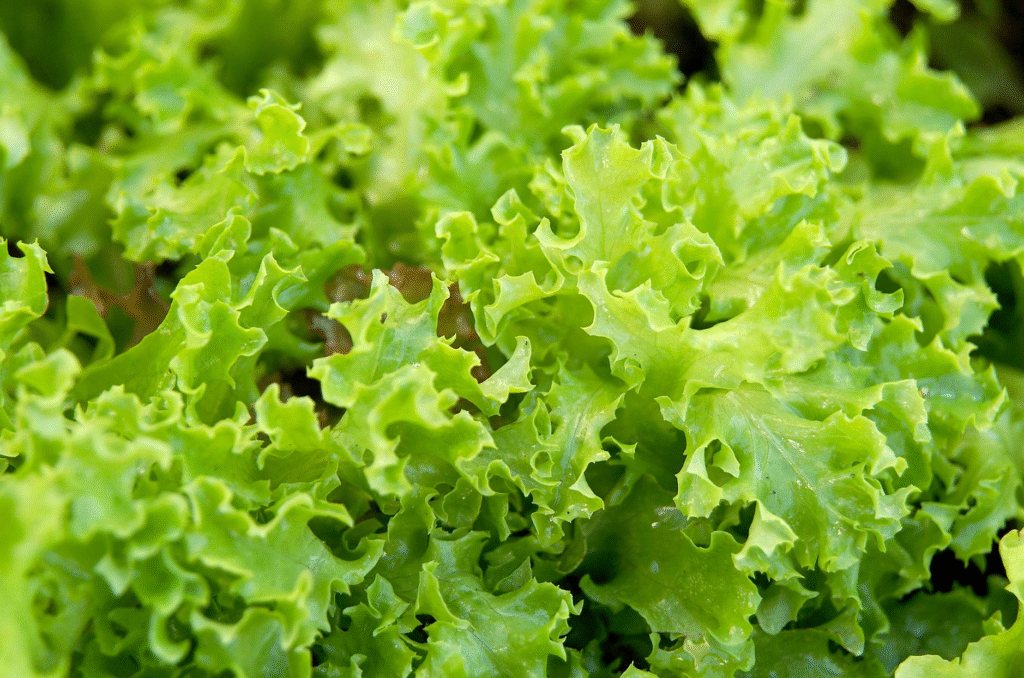
Troubleshooting Common Lettuce Growing Problems
Even experienced gardeners encounter challenges. Here are solutions to common issues:
Bitter Taste
- Cause: Heat stress, beginning to bolt, or over-maturity
- Solution: Harvest younger leaves; provide shade during hot weather; select heat-resistant varieties
Leggy Seedlings
- Cause: Insufficient light or overcrowding
- Solution: Provide more light; thin seedlings; avoid overheating
Bolting (Premature Flowering)
- Cause: High temperatures, long days, or water stress
- Solution: Harvest entire plant when bolting begins; replant with heat-resistant varieties; provide afternoon shade
Soft, Rotting Leaves
- Cause: Poor air circulation, overwatering, or disease
- Solution: Space plants properly; water at base of plants; remove affected leaves immediately
Holes in Leaves
- Cause: Slug damage, flea beetles, or other pests
- Solution: Apply diatomaceous earth; use floating row covers; encourage beneficial insects
Conclusion: Your Year-Round Lettuce Growing Journey
Growing lettuce at home offers tremendous rewards with relatively little effort. By understanding the basics of lettuce varieties, growing conditions, and proper care, you can enjoy a continuous harvest of fresh, flavorful greens throughout the year.
Remember these key takeaways:
- Succession plant: Sow small amounts every 1-2 weeks for continuous harvest
- Adapt to seasons: Switch varieties and growing locations with the changing weather
- Experiment: Try different varieties to discover what grows best in your specific conditions
- Start small: Begin with easy loose-leaf varieties before attempting head-forming types
- Have fun: Growing lettuce connects you to your food in a meaningful, satisfying way
Whether you’re harvesting baby greens from your kitchen windowsill or cutting full heads from your garden, home-grown lettuce represents both practical food production and the simple joy of growing. With the techniques outlined in this guide, you’re well-equipped to start your lettuce-growing journey today.
For more detailed information on vegetable growing, visit the USDA National Agricultural Library’s gardening resources or contact your local Cooperative Extension office for region-specific advice.
